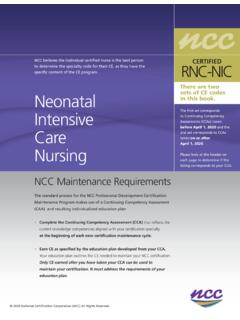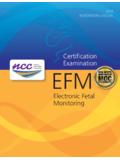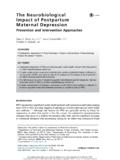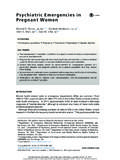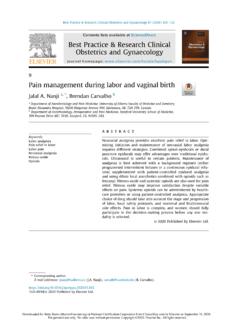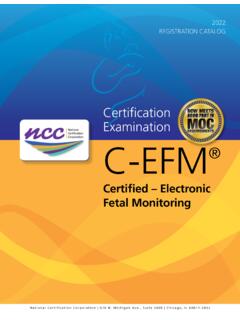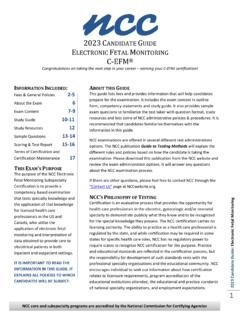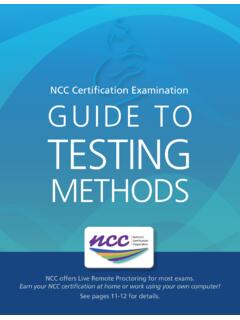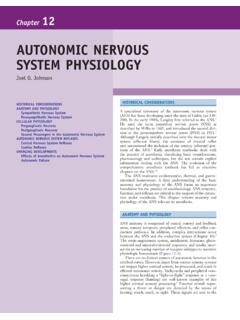Transcription of SARS-CoV-2 Infection and COVID-19 During Pregnancy: A ...
1 REVIEW. SARS-CoV-2 Infection and COVID-19 . During Pregnancy: A Multidisciplinary Review Kavita Narang, MD; Elizabeth Ann L. Enninga, PhD;. Madugodaralalage D. S. K. Gunaratne, MBBS; Eniola R. Ibirogba, MBBS;. Ayssa Teles A. Trad, MD; Amro Elrefaei, MBBCh; Regan N. Theiler, MD, PhD;. Rodrigo Ruano, MD, PhD; Linda M. Szymanski, MD, PhD;. Rana Chakraborty, MD, DPhil; and Vesna D. Garovic, MD, PhD. Abstract The global pandemic of severe acute respiratory syndrome coronavirus 2 ( SARS-CoV-2 ), the cause of coronavirus disease 2019 ( COVID-19 ), has been associated with worse outcomes in several patient populations, including the elderly and those with chronic comorbidities. Data from previous pan- demics and seasonal in uenza suggest that pregnant women may be at increased risk for Infection - associated morbidity and mortality. Physiologic changes in normal pregnancy and metabolic and vascular changes in high-risk pregnancies may affect the pathogenesis or exacerbate the clinical presentation of COVID-19 .
2 Speci cally, SARS-CoV-2 enters the cell via the angiotensin-converting enzyme 2 (ACE2) receptor, which is upregulated in normal pregnancy. Upregulation of ACE2. mediates conversion of angiotensin II (vasoconstrictor) to angiotensin-(1-7) (vasodilator) and con- tributes to relatively low blood pressures, despite upregulation of other components of the renin- angiotensin-aldosterone system. As a result of higher ACE2 expression, pregnant women may be at elevated risk for complications from SARS-CoV-2 Infection . Upon binding to ACE2, SARS-CoV-2 . causes its downregulation, thus lowering angiotensin-(1-7) levels, which can mimic/worsen the vasoconstriction, in ammation, and pro-coagulopathic effects that occur in preeclampsia. Indeed, early reports suggest that, among other adverse outcomes, preeclampsia may be more common in pregnant women with COVID-19 . Medical therapy, During pregnancy and breastfeeding, relies on medications with proven safety, but safety data are often missing for medications in the early stages of clinical trials.
3 We summarize guidelines for medical/obstetric care and outline future directions for optimization of treatment and preventive strategies for pregnant patients with COVID-19 with the understanding that relevant data are limited and rapidly changing. 2020 Mayo Foundation for Medical Education and Research n Mayo Clin Proc. 2020;95(8):1750-1765. morbidity and ,2 Worldwide pop- C. oronaviruses are a family of envel- oped, single-stranded, positive- ulation studies to date have identi ed several From the Maternal Fetal strand RNA viruses characterized patient characteristics, including age and co- Medicine Division ( , , , , , ), by spherical morphologic features with sur- morbid conditions, as risk factors for poor Division of Research ( , face spike projections. Human coronaviruses outcomes, but data on pregnant patients ), and Obstetrics Division are divided into alphacoronaviruses and are limited.
4 Based on data from previous ( ), Department of Ob- stetrics and Gynecology; Di- betacoronaviruses. The rapid emergence pandemics, pregnant women3 are at higher vision of Nephrology and and human-to-human transmission of a risk for acquiring Infection and dying Hypertension, Department of Internal Medicine, and virulent novel lineage B betacoronavirus, se- compared with nonpregnant women. The Department of Obstetrics vere acute respiratory syndrome coronavirus current review provides a multidisciplinary and Gynecology ( , 2 ( SARS-CoV-2 ), has resulted in the global summary of the course and management of Af liations continued at pandemic of coronavirus disease 2019 COVID-19 During pregnancy using an evi- the end of this article. ( COVID-19 ) associated with considerable dence base that has been published since 1750 Mayo Clin Proc. n August 2020;95(8):1750-1765 n n 2020 Mayo Foundation for Medical Education and Research Downloaded for Betty Burns at National Certification Corporation from by Elsevier on August 07, 2020.)
5 For personal use only. No other uses without permission. Copyright 2020. Elsevier Inc. All rights reserved. COVID-19 During PREGNANCY. identi cation of the rst patients in Wuhan, China, in December 2019. ARTICLE HIGHLIGHTS. d Physiologic, metabolic, and vascular changes in normal and TAXONOMY AND PHYLOGENY OF SELECT high-risk pregnancies may affect risks for severe acute respi- HUMAN CORONAVIRUSES. ratory syndrome coronavirus 2 ( SARS-CoV-2 ) Infection and Virion and Viral Life Cycle modify/exacerbate the clinical presentation of coronavirus The capsid of SARS-CoV-2 contains an RNA disease 2019 ( COVID-19 ). genome complexed with a nucleocapsid pro- d Pregnant women may be at greater risk for SARS-CoV-2 . tein. The membrane surrounding this nucle- Infection , with more severe COVID-19 symptoms and worse ocapsid contains 3 proteins common to all pregnancy outcomes. coronaviruses: spike protein, membrane pro- tein M, and small membrane protein E d Studies to date have reported higher risks of pregnancy com- (Figure 1A).
6 4 Viral entry occurs via 2 routes. plications, including preterm birth and preeclampsia, as well as The rst occurs when the spike protein at- higher rates of cesarean delivery. taches to the angiotensin-converting enzyme d Pharmacologic therapy is limited to medications with proven 2 (ACE2) receptor, releasing the viral safety During pregnancy and lactation; safety data are often un- genome and nucleocapsid protein into the available for medications in the early stages of clinical trials. host cell The other pathway is the direct plasma membrane route via trans- d The current recommendations are based on a limited number membrane serine protease 2 (TMPRSS2), of studies. Future large, likely multicenter, studies will be critical which allows for proteolytic cleavage of the in improving our understanding of the pathophysiology and spike protein and mediation of fusion with clinical characteristics of COVID-19 and pregnancy, which may the cell Intracellularly, the viral optimize COVID-19 preventive and treatment strategies During genome is translated into a replicase to pro- normal and high-risk pregnancies.
7 Duce more genome RNA, messenger RNA, and viral protein. Viral membrane proteins M, N, and E assemble on intracellular mem- refractory to the pressor effects of Ang II and branes. The nucleocapsid protein and viral increased levels of Ang-(1-7), which exhibit RNA complex form a helical capsid struc- systemic vasodilatory ,9 In pre- ture, which buds between the endoplasmic eclampsia, a pregnancy-speci c hypertensive reticulum and the Golgi apparatus. Mature disorder that affects of all pregnancies10. viral particles are packaged in vesicles, trans- clinically is characterized by multisystem ported to the cell membrane, and released involvement and, commonly, proteinuria;. from the cell (Figure 1B).5 this balance is lost, with an overexaggerated Ang II blood pressure Preeclamp- Viral Tropism and Normal and High-Risk sia has also been associated with decreased Pregnancies maternal plasma Ang-(1-7) Because The ACE2 enzyme plays a key role in the con- SARS-CoV-2 not only binds to ACE2 but version of angiotensin Ang I to Ang-(1-9) and also causes its downregulation,12 infections Ang II to Ang-(1-7) (vasodilatory, antithrom- During pregnancy may potentiate the RAAS.)
8 Botic, and anti-in ammatory activities) abnormalities, ie, increased Ang II relative to (Figure 2). The hormonal pro le of normal decreased Ang-(1-7), that are present in pre- gestation is characterized by an early increase eclampsia. COVID-19 and preeclampsia share of all the components of the renin- additional common mechanisms, including angiotensin-aldosterone system (RAAS), endothelial cell dysfunction and coagulation including This raises the possibility abnormalities. Notably, ACE2 receptors are that pregnant women may be at a greater also expressed by endothelial cells,13 and risk for SARS-CoV-2 Infection . In addition, endothelial cell Infection and immune low blood pressure in pregnant women is cellemediated endothelial injury have been maintained through a balance between being recently described in Because Mayo Clin Proc. n August 2020;95(8):1750-1765 n 1751. Downloaded for Betty Burns at National Certification Corporation from by Elsevier on August 07, 2020.
9 For personal use only. No other uses without permission. Copyright 2020. Elsevier Inc. All rights reserved. MAYO CLINIC PROCEEDINGS. FIGURE 1. Features and life cycle of severe acute respiratory syndrome coronavirus 2 ( SARS-CoV-2 ). A, Structure of the SARS-CoV-2 viron. B, Viral entry methods and replication of SARS-CoV-2 . the hallmark of preeclampsia is endothelial storm. Cytokine storm is mediated via im- dysfunction,15 Infection with SARS-CoV-2 mune responses, which are signi cantly During pregnancy could mimic and/or initiate modi ed in pregnancy, and may contribute microvascular dysfunction by causing endo- to COVID-19 laboratory and clinical charac- theliitis. Systemic in ammation and microcir- teristics During pregnancy. culatory dysfunction, characterized by vasoconstriction and resultant ischemia, IMMUNE RESPONSES TO COVID-19 . ensue. This can further contribute to a pro- During pregnancy, the maternal immune coagulopathic state, as demonstrated by high system must adjust to tolerate the semiallo- rates of deep vein thrombosis, stroke, and pul- geneic fetus while maintaining its ability to monary embolism, which are increasingly re- respond to pathogenic ,22 This is ported in patients with also known as T helper 2 polarization.
10 How- Infection with SARS-CoV-2 During pregnancy ever, near the end of pregnancy a switch to T. can be particularly prothrombotic because helper 1 immunity occurs and the maternal coagulation abnormalities may potentiate a immune system becomes proin ammatory, hypercoagulable state, which is already pre- leading to the sequence of events that occur sent in uncomplicated pregnancy and exacer- before parturition (ie, cervical dilation , con- bated by Similarly, tractions). Data on immune responses to complement activation, which is present in SARS-CoV-2 in pregnant women are lacking both preeclampsia19 and COVID-19 ,20 may at this time , and data from previous pan- result in particularly severe thrombotic demics, suggest that pregnancy may increase vascular injury when these disease states are the risk of acquiring Infection and dying present concurrently. In summary, RAAS ab- compared with nonpregnant The normalities, endothelial dysfunction, comple- timing of Infection During gestation may ment activation, and the pro-coagulopathic induce differences in maternal immune re- effects of COVID-19 are similar to those occur- sponses, viral clearance, and, ultimately, ring in preeclamptic pregnancies, potentially perinatal outcomes.
